Are you wondering how to elevate your content writing game? You’ve landed at the right place. In the ever-evolving digital world, mastering the art of content writing is crucial — but how can you stand out?
Here’s the deal.
We’re about to take a deep dive and unveil its mysteries by sharing actionable tips that have worked wonders for industry experts. Ever wondered how great writers consistently produce engaging content?
Let’s unravel that, and more.
Ready to become a content writing wizard?
Let’s dive right in.

What is Content Writing?
The term “content writing” covers everything that goes into planning, writing, editing, and publishing written digital marketing content.
It might include a blog post (like the one you’re reading now), video or podcast scripts, social media posts, ebooks, white papers, press releases, web pages, and the like.
Let’s contrast:
- A copywriter focuses on producing persuasive writing (copywriting) that aims to sell.
- A freelance content writer creates web content that educates the reader and helps them fall in love with your company or brand.
Ready to compose killer content?
Let’s dive in.
10 Top Tips for Killer Content Creation
Let’s break down the tips that’ll help you learn how to write quality content that slays…
1. Understand That Content Is Not King

Every other post out there will tell you that “content is king.”
But move over, content. There’s a new ruler in town, and her name is Empathy.
One of the best ways to help your readers fall in love is to put yourself in their shoes.
One of my favorite examples of developing audience empathy comes from this Copyblogger “confession” post by Smart Blogger’s own Writer Extraordinaire and Badass Visionary, Jon Morrow:
Imagine two women, lying in bed.
One can’t sleep because she is worried about her teenage daughter. It’s 2 AM, and she still hasn’t come home. Mom knows it’s probably just normal teenage rebelliousness, but she can’t stop the horrific images going through her head.
It’s the 2 am test: Know what keeps your readers awake at night.
When you know your target audience on a deep level, it helps you create high-quality content that:
- Speaks to their desires, goals, fears, and frustrations, and
- Makes them wonder if you can secretly read their minds.
Figure out where your readers congregate online. Talk to them, read their posts and comments, and take notes about the exact phrases they use to describe their dreams and challenges.
Then you can write a blog post that hits ‘em right in the feels.
2. Write Like a Chameleon
Much like some chameleon species can change skin color to match their surroundings, great content matches the place it’s published.
Before you start writing, think about your content goals. Who’s the intended audience? What style of online content is best for that combination of audience and outcome?
For example, let’s compare how content writing for social media varies across platforms:
- LinkedIn is a professional site, so you should write your online content for a primarily business audience.
- Facebook content can be less polished and more personal.
- Twitter forces you to think in bite-sized ideas with their 280-character limit.
- Instagram is highly image-focused, but a good caption will help your posts stand out from the crowd.
Let’s consider an example from Gary Vaynerchuck:
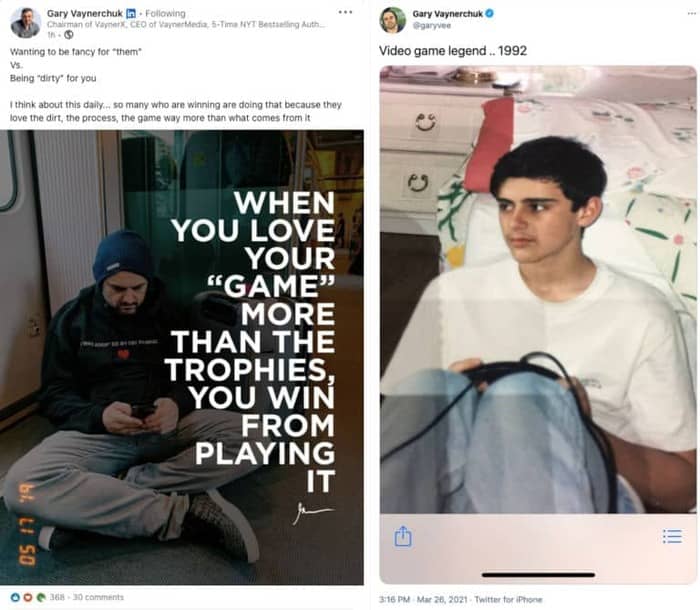
Notice the difference between Gary Vee’s social media post content? LinkedIn is on the left, and Twitter is on the right.
Not only that, ensure you research your competitors.
Pay attention to the headlines they use. Look for patterns in the types of visual media they include. And examine their writing structure. Then use that information to write better content.
3. Stick Out Like a Sore Thumb
Spend much time on the internet? Then you probably know quality content isn’t the norm.
Instead of churning out another boring, crappy, or otherwise inferior piece of written content, consider how you can stand out from the crowd:
- Make your reader the center of attention. Think about what topic angle would interest them the most. Add details that will spark emotion. And show them the benefits of taking action.
- Write original content based on a personal experience. This will allow you to write in a distinctive voice and from a unique perspective. Chances are, at least a few of your audience members will be able to put themselves in your shoes.
- Persuade with powerful prose. Remove the fluff, add power words, and use metaphors to entertain and delight your readers.
One content writing example that uses a powerful personal story is Jon’s On Mothers, Dying, and Fighting for Your Ideas:
Growing up, I always had to fight to get people to listen to me.
The worst part about being disabled isn’t the pain or the struggle but how the world tries to shove you into a corner and pretend that you don’t exist. After all, what could you possibly have to contribute? You’re going to die soon, poor thing. Here’s a nice, quiet room and some morphine to ease the pain.
They don’t proactively hold you back, no, but they don’t expect you to succeed either. I’ve spent my entire life fighting against the weight of those expectations.
Get your creative juices flowing with these creative writing exercises.
4. Give Google What it Wants
In the early Internet days, getting your content in front of the right eyeballs was easy. Write a post, publish, and readers would show up.
But this skill stopped working as more and more writers showed up and started publishing every thought that crossed their minds.
Instead, make friends with Google for enhanced content marketing results.
That means understanding search engine optimization (SEO) basics:
- Primary, secondary, and related keyword research — aim for a combination of low competition and high search volume
- Searcher intent — make sure your reader leaves happy
- Content length and format — readers searching for short videos won’t read a massive ultimate guide, and vice versa
- On-page optimization — ensure that both Google and your readers have a good search experience
Consider getting a leg up on the competition by using a tool like Ubersuggest or Ahrefs:
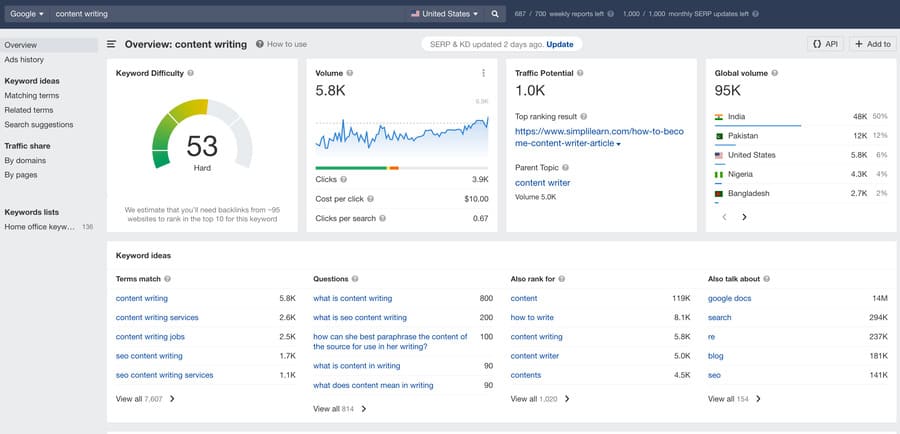
Marketers and writers looking to deepen their knowledge of SEO content writing should check our very own Timeless SEO Writing Tips, Brian Dean’s SEO resource list, and a beginner’s guide to SEO from Ahrefs.
5. Don’t Fly By the Seat of Your Pants
Setting out on your writing journey with nothing more than a vague idea of where you want to go can be a fun way to write a short story or explore a new idea.
But if you want your content marketing strategy to connect with readers and help you reach your goals, planning is the way to go.
A good content strategy will incorporate the SEO content writing tips above with a content brief that ensures everyone is on the same page.
What’s in a content brief?
A good one will include a lot of specific detail about how to make the piece great, including a brief explanation of searcher intent, key insights and takeaways, and an article outline.
In an ideal world, the content brief also includes one possible headline, a list of keywords and relevant terms, the recommended word count, and a list of the ranking competitors and their post URLs.
You can also incorporate the “People also ask” questions from Google:
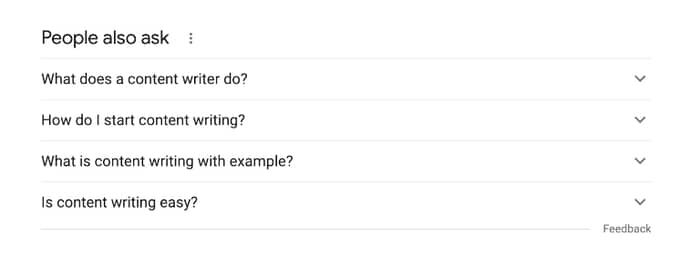
To learn more about crafting a solid content brief, listen to this podcast from the Smart Blogger team.
6. Map Out The Reader’s Journey
Do your competitor research before drafting the complete outline. Reading through the top-ranking posts for the primary keyword will help you understand how to write a better article.
This research process allows you to gather your main points, fill in any gaps, and add new insights (if possible). Then create your article outline, using your subheads as stepping stones to guide your reader.
Finally, brainstorm other potential headlines. To persuade readers to click through:
- Use power words,
- Show the reader how they’ll benefit,
- Use click-through-rate (CTR) boosters like numbers, percentages, or parentheses, and
- Be clear, not clever.
Jon is a master of writing great headlines like this one:
801+ Power Words That Pack a Punch & Convert like Crazy
And with enough outlines under your belt, create a content writing template to make your process faster.
7. Punch Your Reader in the Feels
By now, you hopefully understand how much research and preparation goes into writing a killer piece of content.
The good news is writing the post itself should go a lot faster because of all your prep work!
Start by hooking your reader from the very beginning – a strong intro catches their eye and quickly reassures them they’re in the right place.
Then you can weave your reader into the story, using sweater-knit marketing copy (meaning: no fluff) to tell a compelling story.
For example:
It’s not about how smart you are.
It’s not about the professionalism of your blog design.
It’s not even about giving readers tips they can go out and apply immediately.
It’s about how you make those readers feel.
You want them to cry. You want them to laugh out loud. You want them to shake with anger.
But the most important part?
You want them to feel alive.
Use examples that will emotionally resonate with the middle 80% of your readers, focusing on thoughts, feelings, and experiences they identify with.
Wrap up with a persuasive conclusion that ties back to the introduction.
A compelling conclusion:
- Reminds them where they started,
- Shows them the way forward, and/or
- Gives them a glimpse of the future.
Be clear with your call to action (CTA), so it’s obvious what action they should take next.
8. Write for Humans, Not Robots
Remember back in tip #4 where I told you to write for Google? Now it’s time to add nuance.
The best way to write content that ranks is to write for humans first and then tweak for Google.
Pay attention to the grade level of your writing. Explain things simply and don’t use a lot of buzzwords or complicated explanations.
Use proper article formatting and sentence structure. Short paragraphs and formatting like bolded text and pull quotes will help break up your text.
Be sure to include:
- Engaging and relevant images and videos
- Quotes from experts
- Short “sound bites” for social media sharing
- Internal linking and external high-authority links
And then edit. Edit. And edit again. You can even use content writing services like Grammarly to make your writing clearer and more compelling:
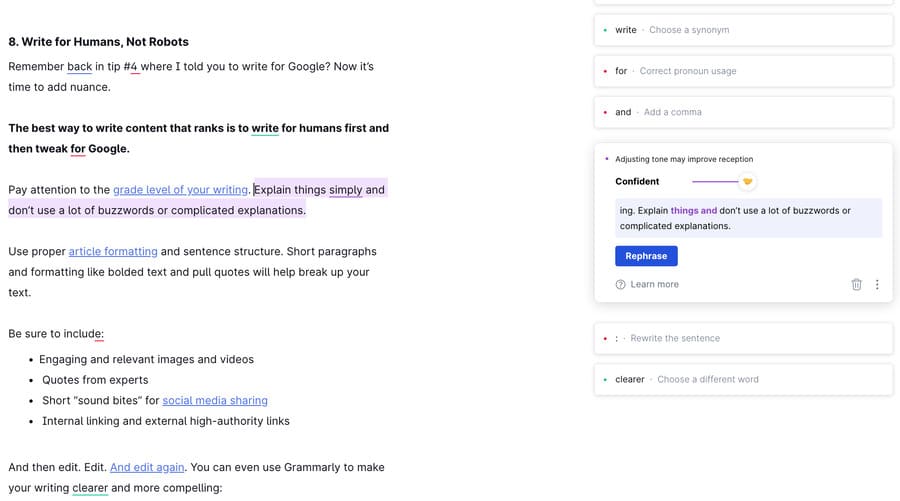
Finally, you can make small SEO adjustments:
- Write a meta description
- Use keywords in relevant tags
- Place secondary keywords and related terms where possible, including in subheads
With a completed post in hand, you might think you’re done. But not so fast!
9. Make Friends With Technology
There are still some writers who think of technology as the enemy. AI is coming for our jobs! (But not so fast. Have you seen the writing quality robots produce?)
The best writers take content writing courses to improve their knowledge. And they use technology and tools to make their lives easier.
From grammar checkers like the Hemingway App and Grammarly to headline analyzers from the teams at CoSchedule, ExactMetrics, and the Advanced Marketing Institute, there’s tons of tech to help your writing grow.
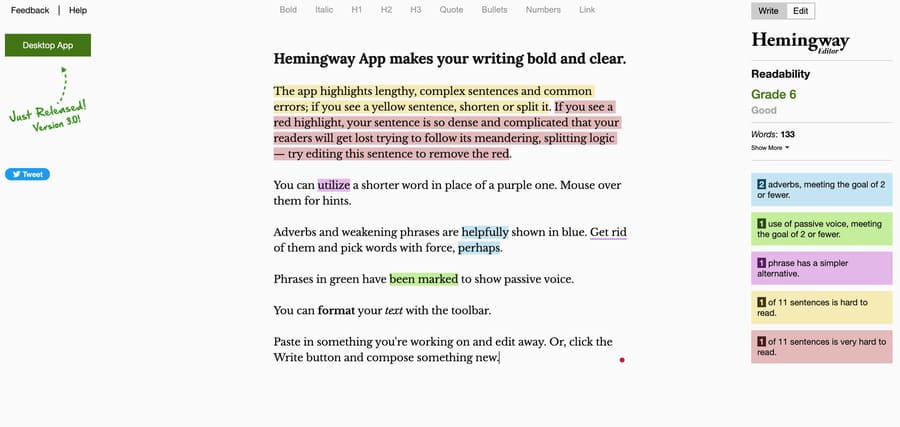
Consider where there’s room for improvement, and then choose the best tool to get you there.
10. Become an Accomplished Content Writer
There’s good news if you’re wondering, “How do I start content writing?”
Whether you’re just learning content writing for beginners or already a professional writer, there are tons of freelance writer gigs out there. Plenty of them even pay a reasonable content writing salary.
And the great folks here at Smart Blogger created an ultimate guide to freelance writing that will help you elevate your writing skills and get hired for paid writing jobs.
As you get your first clients, you can build out your portfolio with content writing samples to show off your new skills.

This writer’s website content uses clear and compelling language to explain what kind of content they write and the results they get.
What’s next along your journey to becoming a content writing pro?
Take Action on These Content Writing Tips
If I’ve done my job as a content marketer, now you’re excited to get out there and start crafting your own engaging content.
Whichever topic or industry you decide to focus on, I hope you’ll become one of those digital content writers who strives to give your readers all the feels — in a good way.
It’s time to get out there and write the world into action. Your readers are waiting on you!




Great article, Jessica! As a freelance content writer who receives briefs (hopefully good ones!) – do you think it’s a reasonable for a client to ask a content writer to come up with things like keywords, or would that be more the role of a content strategist, or an SEO?
Hey Megan! This ia a great question. In an ideal situation, the client will provide as much of the content brief as possible. However, that’s rarely the case. But, at a bare minimum, it’s best if a content strategist, SEO specialist, or someone with a good grasp of what results the company wants to get from their SEO strategy is the one to provide the keywords!
What an outstanding, practical guide for content writers! I really appreciate all the links and resources as well, Jessica. Thank you! The link for this one is in my files because I know I will be checking in repeatedly on some of these concepts.
Thanks so much, Christy! That’s quite the compliment coming from you, and I’m so glad that the article was helpful. It’s always fun to have a resource list that you can go back to again and again.
This was a great read! I love how-tos with a short list.
You had me at “Every other post out there will tell you that “content is king.” But move over, content. There’s a new ruler in town, and her name is Empathy.” <3
Thanks, Dori! Empathy has been such a huge part of what I’ve learned from working with Jon and the Smart Blogger team. It makes writing much more compelling… and has the added benefit of helping your readers reach their dreams and desires!
Great article @Jessica! Definitely agree about using technology to boost your work rather than looking at it as a threat. Also adapting the style to different channels 👌.
Thanks, David! There’s some great tech out there, and we can either fight it or use it to our advantage. Thanks for commenting!
Oooo I like this!
Writing for humans is beyond important these days Jessica, especially with the advent of AI generated blog posts. People sounding “human” by writing for humans makes bloggers stand out more than ever. I picture readers sitting behind laptop screens or phones before writing blog posts, copy or anything else online.
Be human. Sound human. Write for humans. As you aptly noted, tweak for Google but only after writing for people. Perhaps you can SEO-optimize on the 2nd or 3rd draft. Google ranks posts written for people anyway because the algorithm ultimately “knows” that humans use Google.
Excellent post!
Ryan
Great post. Thanks for sharing all these great tips.
Best,
Babett